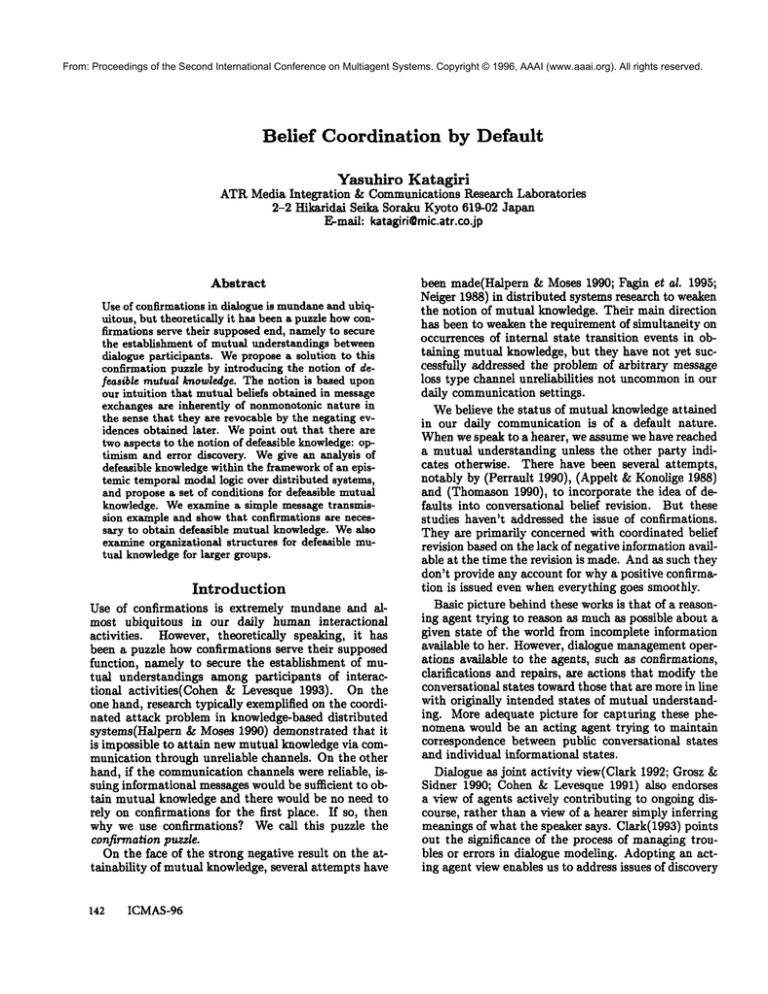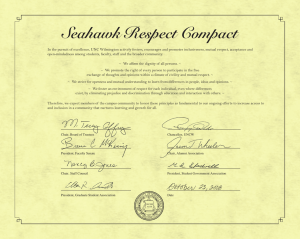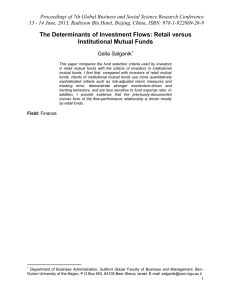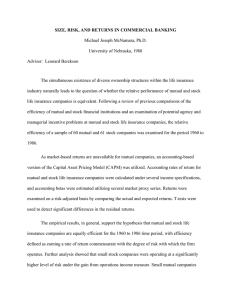
From: Proceedings of the Second International Conference on Multiagent Systems. Copyright © 1996, AAAI (www.aaai.org). All rights reserved.
Belief
Coordination
by Default
Yasuhiro Katagiri
ATRMedia Integration & Communications Research Laboratories
2-2 Hikaridai Seika Soraku Kyoto 619-02 Japan
E-mail: katagiri@mic.atr.co.jp
Abstract
Use of confirmations in dialogue is mundaneand ubiquitous, but theoretically it has been a puzzle howconfirmations serve their supposedend, namelyto secure
the establishment of mutual understandings between
dialogue participants. Wepropose a solution to this
confirmation puzzle by introducing the notion of defeasible mutual Imowledge. The notion is based upon
our intuition that mutual beliefs obtained in message
exchanges are inherently of nonmonotonicnature in
the sense that they are revocable by the negating evidences obtained later. Wepoint out that there are
two aspects to the notion of defeasible knowledge:optimism and error discovery. Wegive an analysis of
defeasible knowledgewithin the frameworkof an epistemic temporal modallogic over distributed systems,
and propose a set of conditions for defeasible mutual
knowledge. Weexamine a simple message transmission exampleand showthat confirmations are necessary to obtain defeasible mutual knowledge. Wealso
examineorganizational structures for defeasible mutual knowledgefor larger groups.
Introduction
Use of confirmations is extremely mundane and almost ubiquitous in our dally human interactional
activities.
However, theoretically speaking, it has
been a puzzle how confirmations serve their supposed
function, namely to secure the establishment of mutual understandings among participants of interactional activities(Cohen
& Levesque 1993). On the
one hand, research typically exemplified on the coordinated attack problem in knowledge-based distributed
systems(Halpern & Moses 1990) demonstrated that
is impossible to attain new mutual knowledge via communication through unreliable channels. On the other
hand, if the communicationchannels were reliable, issuing informational messages would be sufficient to obtain mutual knowledge and there would be no need to
rely on confirmations for the first place. If so, then
why we use confirmations? Wecall this puzzle the
confirmation puzzle.
On the face of the strong negative result on the attalnabUity of mutual knowledge, several attempts have
142 ICMAS-96
been made(Halpern & Moses 1990; Fagin et al. 1995;
Neiger 1988) in distributed systems research to weaken
the notion of mutual knowledge. Their main direction
has been to weaken the requirement of simultaneity on
occurrences of internal state transition events in obtaining mutual knowledge, but they have not yet successfully addressed the problem of arbitrary message
loss type channel unreliabilities
not uncommon
in our
daily communication settings.
Webelieve the status of mutual knowledge attained
in our dally communication is of a default nature.
Whenwe speak to a hearer, we assume we have reached
a mutual understanding unless the other party indicates otherwise. There have been several attempts,
notably by (Perrault 1990), (Appelt & Konolige 1988)
and (Thomason 1990), to incorporate the idea of defaults into conversational belief revision. But these
studies haven’t addressed the issue of confirmations.
They are primarily concerned with coordinated belief
revision based on the lack of negative information a~ilable at the time the revision is made. Andas such they
don’t provide any account for whya positive confirmation is issued even when everything goes smoothly.
Basic picture behind these works is that of a reasoning agent trying to reason as muchas possible about a
given state of the world from incomplete information
available to her. However, dialogue managementoperations available to the agents, such as confirmations,
clarifications and repairs, are actions that modify the
conversational states toward those that are more in line
with originally intended states of mutual understanding. More adequate picture for capturing these phenomena would be an acting agent trying to maintain
correspondence between public conversational states
and individual informational states.
Dialogue as joint activity view(Clark 1992; Grosz
Sidner 1990; Cohen & Levesque 1991) also endorses
a view of agents actively contributing to ongoing discourse, rather than a view of a hearer simply inferring
meanings of what the speaker says. Clark(1993) points
out the significance of the process of managing troubles or errors in dialogue modeling. Adopting an acting agent view enables us to address issues of discovery
From: Proceedings of the Second International Conference on Multiagent Systems. Copyright © 1996, AAAI (www.aaai.org). All rights reserved.
and subsequent recovery from errors. There is usually
a time delay between the time of an utterance and
the subsequent time of signaling and discovery of errors in obtaining mutual understanding. An error once
detected triggers a recovery operation, which leads to
restoration of initially intended states. Weargue in
this paper that the solution to the confirmation puzzle lies in this delayed defeasibility. Eventhough it is
impossible to attain real mutual knowledge, it is possible, with the employmentof confirmations, to attain
a version of mutual knowledge that takes into account
this delayed defeasibility and recovery from errors.
Duality
of Context
The concept of defeasiblity in reasoning has been extensively studied in research on nonmonotonicreasoning and belief revision. The notion of minimization
plays a central role in many of these studies; works
on circumscription(McCarthy 1986), chronological ignorance(Shoham 1986), logic of knowledge and justified assumptions(Lin & Shoham 1992), works on rationality postuLates on belief revision and update(A1chourrSn, G~denfors, & Makinson 1985; Katsuno &
Mendelzon 1991). Wethink of minimization as a way
to capture a double standard or duality of the role
context plays in reasoning. The duality in question
here is the contrast between the actual context on the
one hand, and the idealized or the normal context on
the other. Minimization in nonmonotonic reasoning
provides us with a way of determining a set of legitimate conclusions a reasoning agent can draw from
available information, if the context in which reasoning takes place is normal. Non-monotonic conclusions
are not guaranteed to be correct if the actual context
doesn’t satisfy this normality condition. Wealso find
similar but somewhat different duality of context in
knowledge-based distributed systems.
Nonmonotonic
reasoning
Let’s take a look at minimization in circumscription
and its associated normality condition on contexts.
Normality condition will become more explicit when
we recast the circumscriptive reasoning into epistemic
terms. Shoham(1988)gives a way of capturing circumscription in terms of minimal knowledge entailment.
Think of the following simple set of nonmonotonicreasoning rules about watching a movie on TV. You can
watch a movie by turning on your TV provided that
there are no abnormalities in the situation, which include the power line being unplugged and the TV being
broken.
TV-0NA’~ab D MOVIE
(1)
UNPLUGGEDD ab
BROKEN :Dab
Circumscribing on ab is equivalent to adding the condition (2) below, and then minimizing on knowledge.
ab D Kab
(2)
The added condition (2) explicitly captures the norreality condition on contexts. Drawing a nonmonotonic conclusion MOVIEfrom TV-0Nunder (1) through
circumscription is legitimate only when the context
satisfy (2), namely, all abnormalities must be known
by the reasoning agent. The same condition can be
derived with epistemic reconstruction of default logic
formulation of nonmonotonic reasoning.
The type of normality conditions in nonmonotonic
reasoning reflects emphasis on reasoning. They may
reason about actions, but performance of actions itself
is not within the picture. Whenperforming actions,
abnormalities may not always be known beforehand
when deliberating on outcomes of actions. With action
errors like slipping, fumbling and other types of unreliabilities, abnormalities show up only after actions are
actually taken. To incorporate performance of actions
and its associated possibility of errors, we will require a
weaker version of the normality condition on contexts,
namely that abnormalities will eventually be knownto
agents.
Knowledge
Consistency
Duality of context, in a slightly different flavor, can also
be found in knowledge-based distributed systems. We
can assume two different systems, given a knowledgebased protocol. One system serves to give interpretations for knowledgeconditions in the protocol, and
the other system gives the result of the protocol execution. Neiger(1988) exploits this duality and proposes
the notion of knowledgeconsistency, which intuitively
amountsto the agent-wise indisceruibility between the
two systems. Coexistence of these two systems is also
a manifestation of duality of the ideal and the actual
context for the agents. Neiger showedthat satisfaction
of a specification based only on agents’ local states is
equivalent between the ideal and the actual systems if
they satisfy knowledgeconsistency conditions. As far
as agent’s local states are concerned, agents can assume
the context is ideal whenit is guaranteed to be knowledge consistent with the actual context. Knowledge
consistency has been useful in certain applications, including weakening of the simultaneity requirement for
commonknowledge. But completely ignoring actual
contexts misses the opportunity of error discovery and
subsequent error correction, and it amounts to mere
wishful thinking in some cases if important errors are
left unnoticed.
Modal logical conception of knowledge is external
and implicit(Fagin et al. 1995) in that it is actually
a relational condition between agent states and environment states, and cannot be directly referred to in
selecting actions by agents with incomplete grasp of
their environments(Katagiri 1996). Duality of contexts
is, from the point of view of the agents, a natural way
to realize both reasoning and acting by default. Reasoning gives truthful information only when the supposition of ideal context is a true supposition, and actKatagid
143
From: Proceedings of the Second International Conference on Multiagent Systems.
Copyright
© 1996,
(www.aaai.org).
rights
Runs,
points
andAAAI
systems
A run rAll is
a reserved.
function
ing reveals deviation of actual context from the supposition and thereby providing opportunities to recover
from errors.
A Distributed
System
Model
Agent-Environment
Interaction
for
Wegive in this section basic definitions of distributed
system model on which to develop our notion of defeasible mutual knowledge. Weuse standard concepts and
definitions on distributed systems given in (Fagin ctal.
1995). Our formalization emphasizes the role of environments in mediating between actions and knowledge
states of agents.
A distributed
system model assumes one or more
agents executing their programs in an environment.
Execution of programs can bring about changes both
in environment and in agents. It is not guaranteed
that execution of programs brings about a constant
effect. One agent’s program step may interfere with
other agents’ program step, and environment may also
non-deterministically intervene program execution and
change the outcome.
Basics
Wedefine a distributed system to be a set of n agents
{al,...,an}
executing their programs in an environment e.
States A system state s can be described by a tuple of an environmental state and local states of each
agents, (se, Sl,..., s,~). local st ate s~of each agent ai
at a given instant is taken from a corresponding set of
local states S~. An environmental state se is similarly
taken from a set Se. The behavior of the system can
be specified as transitions in the set of systemstates S.
Wewill also write a0 and so for e and se, respectively,
for expository convenience.
A basic proposition corresponds to a set of system
states. Wedenote a set of system states in which a
basic proposition p holds by Sr A basic proposition is
a local state condition ~ of an agent ai, if it is solely
determined by a set of a~’s local states.
Protocols and transition
functions
We assume
a set ACT~of basic acts for each agent a~. A protocol II is a tuple of local protocol IIi’s. II~ specifies which act to execute based on local states of
a~; Hi : S~ --* 2AcT~. We assume that the environment may act non-deterministically,
but other agents
are deterministic, that is, the value of IIi is a singleton set for i > 1. A transition function 7" specifies the transition of the entire system state given
all the acts executed by agents and the environment:
St+l = 7(acre, act1,..., actn)(st). represents th e outcome of actions of all the agents. This includes each
agent’s internal state change upon receiving information about actions performed.
144
ICMAS-96
r : N -* S which gives a system state r(t) for each
time point t. Wewrite ri(t) for the corresponding local
state of ai. Wecall It, t) a point in a run r. Wesay for
an agent ai, points (r,t) and (r’,t ~) are ai-cquivalent
if ri(t) = rti(tl), and write (r,t) ,,q I,t’). A system
A is identified with a set of runs that corresponds to
all executions of the protocol II under the transition
function 7.
Knowledge and time We regard a system of runs
as a Kripke structure and introduce modalities of both
knowledge and time.
Knowledgeis a relational condition between agents’
local states and entire system states. Weassume $5
for knowledge, and write K~,~o to represent that the
agent a~ knowsthat ~o. From knowledge modalities for
individual agents, we define group knowledge EG (everybody in the group G knows): E
a= A~eG K~,~o.
G~def
Mutual knowledge MKG~oin a group G is defined in
terms of Eo~a as the largest fixed point of the equation X = Eo(~o ^ X). Eventual group knowledge E~o
is defined by weakening the condition of simultaneity
of the knowing. Everybody in the group G eventually
knows~ if and only if for every agent a~ in G there is
a time point ti such that a~ knowsta at t~. Eventual
mutual knowledge MK~ois similarly defined in terms
of
Since each run in a system has a linear temporal
structure, we introduce temporal moralities, O and its
dual D, in a standard way.
Satisfaction
conditions
When~o holds at a point (r, t) in the system A, we say
(r, t) in A satisfies ta and write A, r, t ~ ~a. Wealso
write A ~ ~a when all the points in A satisfies 0;. We
state the satisfaction conditions for formulas below.
¯ Whenp is a basic proposition, A, r, t ~ p iff r(t)
¯ A, r, t ~ -~o iff it is not the case that A, r, t ~ ~o.
¯ A,r,t~o^~biffA,
r,t~gandA,
r,t~b.
¯ A,r,t ~ Kavaifffor all (r’,t’) G if (r, t) ,.. ~ (r’ ,t’)
then A, r’, t ~ ~ ~o.
¯ A, r, t ~ (>~ iff there exists t’ such that t < t’ and
A,r, t’ [= ~o.
Knowledge consistency
and beliefs
Recall that we related the notion of duality of context,
ideal and actual, with a picture of agents reasoning and
acting by default, whohave the capability of incorporating possibilities of errors. Weintroduce the notion
of weak knowledge consistency, by extending Neiger’s
notion of knowledgeconsistency, which prescribes the
condition on the relationship between the actual system A and the ideal system I. Wedefine the notion
of beliefs based on the duality of A and I. The idea
is that we require every run in the actual system A to
be almost indiscernible for all the agents to some run
From: Proceedings of the Second International Conference on Multiagent Systems. Copyright © 1996, AAAI (www.aaai.org). All rights reserved.
in the ideal system I, except for some states in which
one or more agents notice the deviation and try to get
back onto the right track. Wedefine beliefs on top of
this duality. Anagent a~ believes ~ itf ~ holds in every
ai-equivalent system state in every ideal system I.
¯ Weak knowledge consistency of runs
A run r is weakly knowledge consistent with another run r’, r H_~r’, iff there is a monotone
increasing mapping pi : N --* N for each agent
ai such that (r, t) ~i (r’, pi(t)) for
¯ Preference order on systems
A system A2 is preferred over another system
A1, A1_E A2, itfA2 is a subset Of A1, A1 _D A2,
and for all r’ E A1there exists r E A2 such that
rI1_~
r’.
WhenA~ is preferred over A1, every run in A1 has
its counterpart with less deviations in A2. Both weak
knowledgeconsistency relation ]]~ and preference relation U_are partial order. For any-local state condition
and systems Ax,A2, if AI _= A2 and A2 ~ Oct then
AI ~ O~ also holds.
Wedefine beliefs Ba~~ of an agent a~ relative to ideal
systems I which are maximally preferred over the actual system A.
¯ A, r, t ~ B~,~ itf for all maximally preferred system I satisfying AE_I, for all (r’,t’)
6. I, if
(r, t) "i I, t I) then I,r I, t I ~~.
An agent ai believes that ~ if ~a holds in all a~equivalent system states with the assumption that the
context is ideal. This definition of beliefs satisfies
KD45axioms. Group beliefs AG, mutual beliefs MB
a
and their eventual counterparts A~ and MB~are defined in parallel to the definitions given for knowledge.
Defeasible
Mutual Knowledge
Informal
characterization
Wethink we can capture the defensibility
of mutual
knowledge among acting agents by the following two
complementary components. Agents jump to conclusions with incomplete information and act on them.
Agents also recover from errors when mistakes are discovered later. Wepropose to characterize the notion
of defensible mutual knowledge with these two components.
Optimism: Defensible mutual knowledge would
amount to real mutual knowledge, if the environment were ideal.
Error discovery: In reality any deviation from mutual knowledgewill jointly be noticed.
Conditions
for defeasible
mutual
knowledge
Wefirst propose a set of conditions for defeasible mutual knowledge in formal terms. We then argue that
these conditions capture our intuition on defensibility
of mutual knowledge among acting agents, through examination of logical consequences derived from the proposed conditions.
Condition 1 (DMKcondition)
To achieve defeasible mutual knowledge of ~ in a system A among
members of a group G, there has to be a local state
condition ~ for each agent al, and they have to satisfy
the following conditions:
¯ Knowledge in ideal context:
For every agent ai E G, I ~ ~i ¢~ Ka, ~a.
¯ Eventual notice of success:
For every agent ai E G, I ~ O~i.
¯ Simultaneity:
For any pair of agents al and a j, I ~ ~ ~ ~j.
¯ Future error discovery:
There exists a subset G~ of G such that for every
agent ai E G’, A ~ a~ D (-~ D OKa~-~a).
First three conditions correspond to the optimism component of defeasible mutual knowledge. If the context
were ideal, membersof the group have to undergo simultaneous internal state change at some time each of
which amounts to the knowing of ~. The fourth condition corresponds to the error discovery component. It
is necessary at least for some member(s) of the group
to notice if an error has occurred in order to avoid a
state of collective illusion. Wecall membersof G’ sober
agents.
Aspect of optimism
Westate several logical consequences of the DMK
conditions in the form of propositions below. First we examine optimism. General cases can be described by
the following proposition.
Proposition
1 If the DMKcondition
holds,
then
Proof From the equivalence of knowledge in I and
beliefs in A, and simultaneity, it is easy to see that for
arbitrary ai,aj E G, A ~ai D ~Baj(~oAo’i ). Hence,
A ~ ai D A~(~ ^~i). From the induction rule for
eventual mutual beliefs, A ~ ai D MB~. From eventuai notice of success it follows that A ~ MB~.
So, if the DMK
condition holds, an eventual mutual belief amongmemberof G obtains. The following proposition shows that when a stronger condition holds, real
mutual belief obtains even though nobody may notice
when it happens.
Proposition 2 If, in addition to the DMKcondition,
A ~ O A~ ~G ~ holds, then A ~ <>MBo~.
Proof Let ¢~ to denote A~,~o ~ri. It is easy to
see that A ~ ¢o ~ Ao(~0 ^ ¢o). From induction rule
and the condition of the proposition, the conclusion
A ~ OMBo~pfollows.
Katagiri
145
of oferror
discovery
An (www.aaai.org).
Example
From:Aspect
Proceedings
the Second
International Conference on Multiagent Systems. Copyright © 1996, AAAI
All rights reserved.
For error discovery, the following proposition shows
that the DMKcondition guarantees an eventual mutual knowledge among sober agents in G~ that errors
will at least be noticed by some members of sober
agents.
Proposition 3 If the DMKcondition
A ~ MK~,(-~ D V.,ea,
holds, then
OK.,-~o).
Proof Let 8i be -~o D OK~-~o, and On, be Va, ea, 0~.
$a, is equivalent to -,~p D Va, ea, OK~,-~. From the
eventual notice of success condition, it follows for any
ai, ai e G’ that A ~ Ks, Oni. Let ~be, be Aa, co, <>~r~.
Using the error discovery condition it follows that
A ~ a~ D K~, (Oi ^ ~bo,). Since A ~ 0i D Oo,, it follows that A I= a~ D Ke~ (0o, ^ ~ba,). Since eG’
Oai for any ai, A ~ Ca, 30K~, (00, A ¢o,) for every ai. it follows that A ~ Ca, D E~, (0a, A ~ba,), and
hence from the induction rule for mutual knowledge,
o Oa,. Since eventual notice of sucA ~ ~b~o D MKo,
cess implies A ~ ~bc,, the conclusion of the proposition
A ~ MK~, On, follows.
The following proposition is aa easy corollary of the
proposition 3. It shows that if knowledgeis guaranteed
even in the actual context, eventual mutual knowledge
is guaranteed.
Proposition 4 If, in addition to the DMKcondition,
each agent ai E G has a local state which corresponds
to knowledgeof ~0 not only in the ideal system I, but
also in the actual system A, that is, A ~ ~i ¢~ K,~ ~,
then eventual mutual knowledge among all the members of the group G will obtain, A ~ MK~.
The above results show that in general it is only
guaranteed that mutual knowledge among sober agents
is of disjunctive nature, that is, only somebodynotices
the error. In order to obtain a stronger mutual knowledge on error discovery, we need a stronger condition.
Proposition 5 If a stronger version of the future error
discovery condition, A ~ -~ D OK~-~ofor all sober
agent ai E G~, holds, then
A ~ MKo(-,~o D MK~,-,~).
Proof Since the stronger error recovery condition
A ~ -,~0 D OK~-,~o holds for every agent ai E Gt, aa
error is guaranteed to become eventual group knowl° -1w.^ The conedge among G~, that is, A ~ -~o DE(~,
clusion follows from the induction rule for mutual
knowledge.
This proposition shows that when error discovery is always guaranteed, then it is mutual knowledge among
all the members of the entire group G that occurrences of errors will becomeeventual mutual knowledge
amongthe sober agents in G’.
146
ICMAS-96
Weexamine a simple message transmission example,
which is a simplified version of acknowledgment-based
message transmission protocol in computer communications. Wechoose this example as a rough approximation of human communication with confirmations,
in which we can see howdefensible mutual knowledgeis
realized by joint behaviors of a sender and a receiver.
The example demonstrates that the use of confirmations is necessary to establish defensible mutual knowledge.
Imagine two agents, a sender S and a receiver R, executing the following programs within the environment
E.
S:
R:
E:
then
if m-~
if mI~A~RR then
if true
then
send-m
send-a
+ll-
Local states of S and R both consist of two binary
valued components m and a. They stand for messages
and acknowledgments. Weuse subscripts to indicate
to whomthe local states belong. S executes an act
of sending a message send-m whenever she is in states
where mS is false, and no action is performed otherwise. Similarly R executes aa act of sending back an
acknowledgmentsend-a whenever he is in states where
mR is true and air is false, and no action is performed
otherwise. The environment E always acts nondeterministically to effect the success or failure of delivery
of both the messages and the acknowledgments. We
assume fairness in the behavior of the environment.
So, it is not the case that neither success nor failure
indefinitely continues in any execution. Weassume the
system starts from a state in which neither the messages nor the acknowledgmentsare sent out.
Transition function ~- of the system is given in Table 1. Each element in the table shows the resultant
state of an action on the top of the column performed
in a state on the leftmost in the row. So, starting at
the state labeled (A), if send-ra is performed by S and
no action is performed by R and the environment is
cooperative, then both S and R switch their respective m state components,mS and mR,to positive values,
while retaining negative values for a S and air. This
corresponds to a transition where both S and R come
to think that the message is delivered. Unfilled portion of the table is irrelevant here since cases we are
interested in axe those where the system starts from a
particular state (A).
Our target proposition for mutual knowledge is the
proposition ~ that both a message and aa acknowledgment are successfully delivered. It is a conjunction of
two propositions: a proposition p,,, that a message has
been delivered, and a proposition p~ that an acknowledgment has been delivered. Weregard that both p,n
and Pa become true once a message or an acknowledgment is successfully delivered and stay true even if the
agents keep sending messages/acknowledgments to the
From: Proceedings of the Second International Conference on Multiagent Systems. Copyright © 1996, AAAI (www.aaai.org). All rights reserved.
Table 1: Transition function r for a message transmission system.
L
(A)
(B)
me. ~
nit aK
n s as
~
~
at~
mS
aS
(C)
mR aK
aS aS
(D)
all
(E), ag
(F)
mg ~
aK
mS as
mR aR
A
/
/
<
\
/ "/
~ \D
/
~. \F
%
E
/
aS
aR
as I
the union of the ai-equivalence of S and R, the resulting relation covers all the nodes in the system. Even
eventual mutual knowledge does not obtain in A, since
there is no local states of R that corresponds to knowledge of ~o. But there is still an intuitive appeal in saying
that somemutuality is achieved by the exchange in this
example, since a variant of this type of exchangeis actually employed in computer communications and this
example definitely mimics certain important aspects of
humanuse of confirmations in conversations.
\
/
\
aK
as
aR
ag
I s
\
s"
ms
aA
/ s s
Figure 1: The actual system A and the ideal system I.
other parties.
The actual system A generated by the protocol and
the transition function is shownin Figure 1. At a leaf
system state, transition continues from the node within
the tree which has the same label, except for the state
labeled C. The state C repeats indefinitely in the system. The state C is the only state in which both p,n
and Pa hold, and it is also the only state in which all
the local state components for S and R are true.
The first point of this exampleis that the exchangeof
messages and acknowledgments here does not achieve
mutual knowledgein its strict sense. Even though our
target proposition ~ is equivalent to mS A aS A~R A aR,
S and R does not establish mutual knowledge of ~ in
the entire system. If we take the transitive closure of
The second point of this example is that we can
show that the proposition ~ becomes defeasible mutual knowledgebetween S and R in the sense described
in the previous section. It is easy to see that we can
take as the ideal system I the part of A surrounded
by the dashed line in Figure 1. I is preferred over A
because the only run in I is weakly knowledgeconsistent with all the runs in A, and I is obviously the most
preferred system. Within / it is easy to see that local
conditions ~rs = mS A aS for S and err = mR A aR for R
satisfy all the first three conditions in the DMK
condition, e.g., knowledgein ideal context, eventual notice
of success and simultaneity. Furthermore, fairness requirement on the environment ensures that both ~s
and ~rR will jointly be realized in the system state C
eventually. From Proposition 2, we can say that S
and R will eventually reach an actual mutual belief on
~o. On the other hand, the entire system A satisfies
the stronger version of the future error discovery condition. The local state condition ~ serves to indicate
S’s discovery of errors about sharing of pro, and the local state condition ~RRserves to indicate R’s discovery
of errors about sharing of Pa. From Proposition 5, we
can say that S and R mutually knowthat an error will
become eventual mutual knowledge between S and R.
The final point about this example is that defeasible
mutual knowledgeis attained through joint actions of
Katagiri
147
From: Proceedings of the Second International Conference on Multiagent Systems. Copyright © 1996, AAAI (www.aaai.org). All rights reserved.
-tnlO
-4-
~
-/-
mn.ll~--~
(a) Loop m’ucnue
(b) Sequential structure
(a)/.nitia~r typeaiPmtprogram.
.
mi’l/"
"/mi
( LAy LB ~0~
,4-
(b) Followertypeallmi
(d) Parallel sUr~Lure
(c) Hierachi©alstructuure
Figure 2: Twoagent program types for belief coordination by message passing.
Figure 3: Organizational structures for belief coordination in large groups.
both S and R. As the protocol for S and R together
with the transition function shows, not only they act
for the end of establishing ~, but both of them act
together to recover from errors when they find one.
Both of the programs of S and R serve for these dual
purposes. Defeasible mutual knowledge was only possible because both parties jointly take part in these
achievement/error recovery processes. Confirmations
are necessary to realize this joint involvement between
speaker and hearer.
types of operations for this purpose.
¯ Composition Pl o P2
Two initiator type programs Pl and P2 can be
concatenated by identifying the last node of Pl
with the first node of p2 (COHP1).The resultant programis of the initiator type. An initiator program P2 can be embeddedinto a foUower
program pl at the node 1 position ofpi (COMP2).
The resulting programis of the follower type.
¯ Product Plli Pi
The product Pl ]i Ps operates on the direct
product of the program states for Pl and P2,
where Pl and Ps work on each components of
the product states.
The basic organizational structure formed by these
programs are loops, shown in Figure 3(a). The two
party exchangein the last section is the simplest example of a loop. Weneed exactly one initiator in a loop.
At least one initiator is necessary to start messageexchange processes, while having two or more initiators
in a loop doesn’t help, since even if there were two or
more initiators in a loop, each initiator would have to
workas a follower for messagesoriginated by other initiators in order for each initiators to knowthat their
own messages successfully made it through the loop.
The initiator reinitiates messagesending cycle in case
she doesn’t get an appropriate success signal within a
certain time bound.
Wecan generate various complex organizational
structures out of loops. Three different types of organizational structures are shown in Figure 3(b)-(d).
These structures are generated by corresponding complex programs constructed by the operations above.
Organizational Structure for Belief
Coordination
To establish defeasible mutual knowledge among a
group of more than two agents, we need to have an organizational structure for message exchange. Wewill
concentrate here on types of organizational structures
for message exchanges, and exclude mutual knowledge
obtained through copresence in a shared environment,
which doesn’t require message exchanges.
Generalizing the example in the previous section, we
can see that a variety of organizational structures can
be generated from two basic types of agent programs
which correspond to the sender and the receiver in the
example. Twobasic types of agent programs are shown
in Figure 2. The initiator type programis a generalization of the sender program to n membergroups. The
follower type program is the receiver program which
can also work within larger groups. Nodes and arcs in
the figure represent program states and program execution steps. Labels on arcs indicate input/output for
the execution steps represented by the arcs.
We can also make complex programs out of these
basic programs by combining programs. There are two
148
ICMAS-96
From: Proceedings of the Second International Conference on Multiagent Systems. Copyright © 1996, AAAI (www.aaai.org). All rights reserved.
(i) Sequential structure
The group G consists
of several groups
L1, L2,...,
each of which forms a loop. All
subloops share one agent. The shared agent executes a program formed by composing initiator
type programs with C01~P1operations. Subloops
execute sequentially.
(ii) Hierarchical structure
The group G is a union of a mother group P and
several other subordinate groups Cj’s. Some
agents are members of both the mother group P
and one of the subordinate groups Cj. Each of
these shared agents executes a program formed
by composing a follower program and an initiator type program with COMP2operation. She
forwards a message in P only after she successfully completed the cycle in Cj.
(iii) Parallel structure
The group G consists of several subgroups
A,B,...,
each of which forms a loop. All
subloops share one agent. The shared agent
executes a program formed by product operations. Subloops work in parallel, and they do
not exhibit hierarchical dependencies.
Conclusions
Weproposed a solution to the confirmation puzzle by
introducing the notion of defensible mutual knowledge
for characterizing informational states of agents actively participating in joint activities. The notion utilizes the duality of context implicit in nonmonotonic
reasoning and knowledge-based distributed systems research. Weclaimed that the notion captures our intuition about mutual understanding attained in our daily
communication by separating out mutual knowledge
in ideal setting and discovery of errors in actual environment. Weformally stated conditions for defensible mutual knowledge within an epistemic and temporal modal logical frameworkover distributed systems,
and examined their logical consequences. Wefurther
demonstrated by an example that confirmations are
a necessary part in obtaining defeasible mutual knowledge. Wealso showedthat organizational structures in
larger groups for defensible mutual knowledge can be
derived by extending the confirmation-based message
exchange structure.
Our notion of defensible mutual knowledge comes
from a view of acting agents, and we believe that the
~rk reported here provides us with a novel and better
perspective for analysis of interplay between knowledge
and actions in joint activities including everyday conversations.
References
AlchourrSn, C. E.; G~rdenfors, P.; and Makinson, D.
1985. On the logic of theory changes: Partial meet con-
traction and revision functions. Journal of SymbolicLogic
50:510-530.
Appelt, D. E., and Konolige, K. 1988. A practical nonmonotonictheory for reasoning about speech act. In Proceedings of the ~6th AnnualMeetingof the Association of
ComputationalLinguistics.
Clark, H. H. 1992. Arenas of LanguageUse. The University of ChicagoPress.
Clark, H. H. 1993. Managingproblems in speaking. In
International Symposiumon Spoken Dialogue, 181-184.
WasedaUniversity.
Cohen, P. R., and Levesque, H. J. 1991. Confirmations
and joint action. In Proceedings of the Twelfth International Joint Conferenceon Artificial Intelligence, 951957.
Cohen,P. B.., and Levesque,H. J. 1993. Preliminaries to
a collaborative modelof dialogue. In International Symposium on Spoken Dialogue, 261-266. WasedaUniversity.
Fagin, R.; Halpern, J. Y.; Moses, Y.; and Vardi, M. Y.
1995. Reasoning about Knowledge. MITPress.
Gresz, B. J., and Siduer, C. L. 1990. Plans for discourse.
In Cohen, P. R.; Morgan, J.; and Pollack, M. E., eds.,
Intentions in Communication. MITPress. chapter 20,
417--444.
Halpern, J. Y., and Moses, Y. 1990. Knowledge and
common-knowledge
in a distributed environment. Journal
of the ACM37(3):549-587.
Katagiri, Y. 1996. A distributed systemmodelfor actions
of situated agents. In Seligman,J., and Westerst£hl, D.,
eds., Logic, Languageand Computation. Center for the
Study of Languageand Information, Stanford University.
317-332.
Katsuno, H., and Mendelzon,A. O. 1991. On the difference between updating a knowledgebase and revising it.
In Proceedingsof the SecondInternational Conferenceon
Principles of KnowledgeRepresentation and Reasoning,
387-394.
Lin, F., and Shoham,Y. 1992. A logic of knowledgeand
justified assumptions.Artificial Intelligence 57:271-289.
McCarthy,J. 1986. Applications of circumscriptionto forrealizing common-sense
knowledge.Artificial Intelligence
28:89-116.
Neiger, G. 1988. Knowledgeconsistency: a useful suspension of disbelief. In Vardi, M. Y., ed., Proceedingsof the
Second Conference on Theoretical Aspect8 of Reasoning
about Knowledge, 295-308. Morgan Kaufmann.
Perrault, C. R. 1990. An application of default logic to
speech act theory. In Cohen, P. R.; Morgan,J. L.; and
Pollack, M. E., eds., Intention in Communication.MIT
Press. 105-133.
Shoham,Y. 1986. Chronological ignorance: Time, nonmonotonicityand necessity. In Proceedingsof AAAI, 389393.
Shoham, Y. 1988. Rcasoni,9 about Chanye: Time and
Causationfrom the Standpoint of Artificial Intelligence.
MITPress.
Thomason,R. H. 1990. Propagating epistemic coordination throughmutualdefaults I. In Parikh, P., ed., Proceedings of the SecondConference on Theoretical Aspects of
Reasoning about Knowledge, 29-39. Morgan Kaufmann.
Katagiri
149










